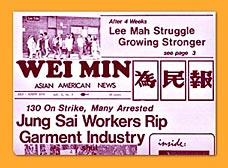|
|
|
|
|
||||
|
|
|
|
|
|
|
|
 |
Cover of a newspaper published by Wei Min She, an Asian anti-imperialist organization in San Francisco. Striking workers at Lee Mah, an electronics manufacturer, and Jung Sai, a garment factory. Supporters of both strikes joined these struggles together in a series of rallies and programs in Chinatown. But attempts to draw support from other workers through highlighting the larger class-based issues became controversial because it meant seeing things in a new way, as Steve Louie explains (see text below). |
When We Wanted It Done, We Did It Ourselves[excerpt]
My decision to work on a truck dock unloading tractor-trailers to organize among workers of color was a political decision and something I sought, along with others I knew in the Movement. But it was much harder to shed ideas I’d grown up with about what it meant to work with my hands, and to deal with how difficult it was to organize a workers’ caucus. To this day, those 12 years of unloading trucks were the most important days of my life. I worked with others to get organized, to deal with problems on the job and support community issues like the International Hotel [where low-income seniors were being evicted]. I learned more about respect for people as human beings, more about what people care about in their lives, and how perceptively everyday people can analyze situations and the world around them than I have learned at any other point in my life. These experiences taught me about how to listen to what people need instead of making assumptions, and how to act with them to get things done. |
||||||
